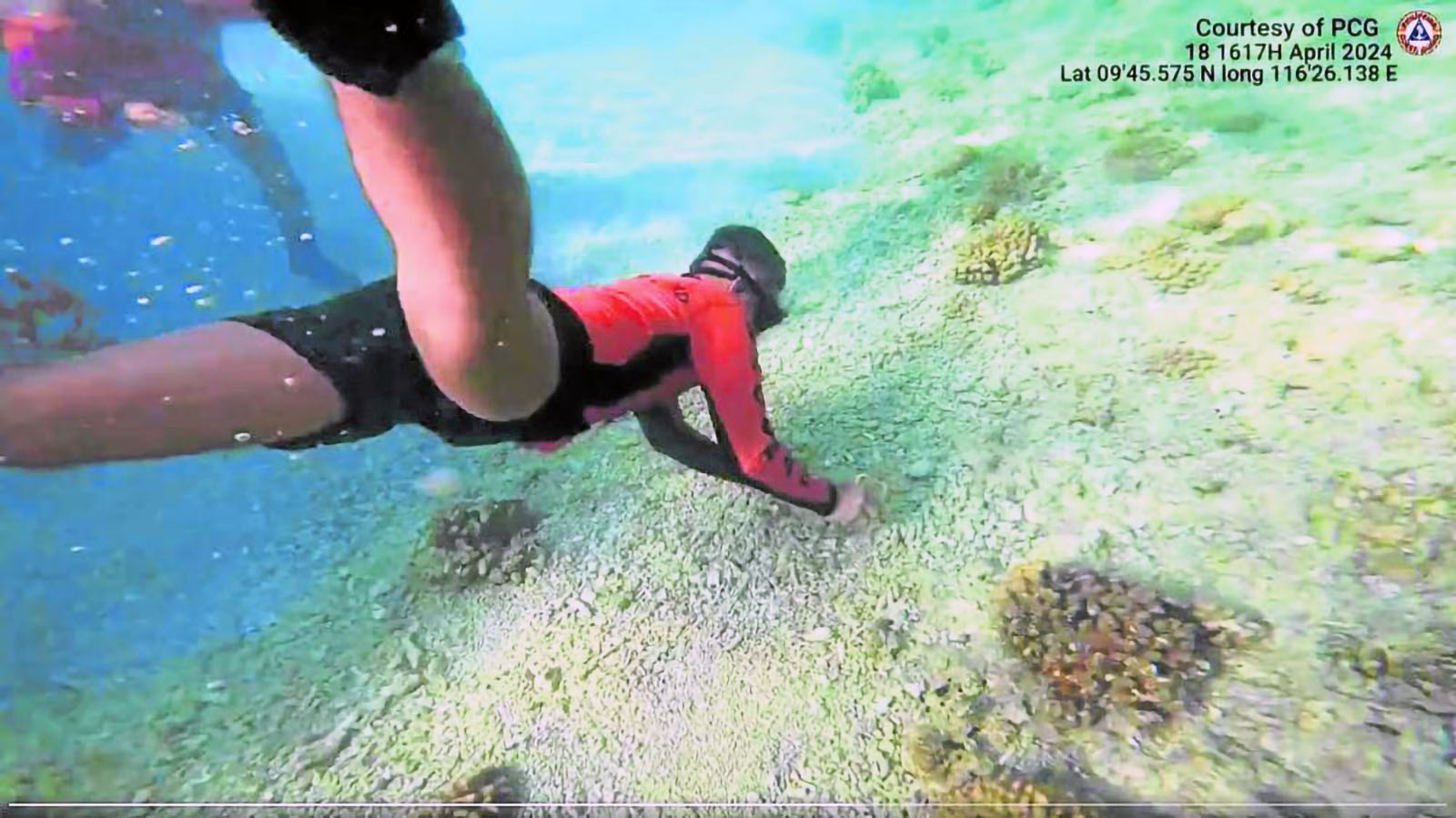
TROUBLING FIND On the surface and underwater, Philippine Coast Guard divers find piles of dead corals in Escoda (Sabina) Shoal, taking them as signs of another island-building activity by the Chinese. PHOTO FROM THE X POSTS OF PCG SPOKESPERSON COMMODORE JAY TARRIELA
MANILA, Philippines — The Philippine Coast Guard (PCG) has discovered another “very alarming” indication of early-stage land reclamation likely by the Chinese at a Philippine shoal much closer to Palawan than China’s largest artificial island within the country’s exclusive economic zone, a coast guard official said on Saturday.
A week after reporting China’s attempt at small-scale land reclamation in the waters off Pag-asa (Thitu) Island in the West Philippine Sea, the PCG said it discovered crushed dead corals at Escoda (Sabina) Shoal and 44 Chinese ships and research vessels in the area.
READ: China seen behind new WPS island-building
Commodore Jay Tarriela, the PCG spokesperson for the West Philippine Sea, said the dead corals appeared to have been dumped as preparation for reclamation — similar to the coral rubble that the PCG and Filipino marine scientists found at Sandy Cays near Pag-asa Island last March.
“It is very alarming because Escoda Shoal is just 75 nautical miles (135 kilometers) away from the coastline of Palawan. That’s how close they are getting,” Tarriela said at a forum in Quezon City.
“I look at the People’s Republic of China as the most probable actor responsible for small-scale reclamation not just in Sandy Cays but also here in Escoda Shoal,” he said.
The shoal is about 135 km northwest of Rizal, the town in Palawan closest to it in the West Philippine Sea. China built its biggest artificial island on Panganiban (Mischief) Reef, which the Chinese started occupying in 1995, about 240 km northwest of Rizal.
The PCG surveyed the reef around Escoda following intelligence reports on the presence of Chinese ships there and the results of the marine scientific research on Sandy Cays.
Rendezvous point
Tarriela said there were 34 Chinese maritime militia vessels, four China Coast Guard (CCG) ships, three People’s Liberation Army-Navy (PLA-N) ships and three Chinese research and surveillance vessels in the waters of Escoda. The Chinese also had one PLA-N helicopter.
Escoda is the rendezvous point for the country’s rotation and resupply missions to the BRP Sierra Madre at Ayungin (Second Thomas) Shoal, which is about 37 km from Panganiban.
“Ayungin Shoal is farther than Escoda Shoal and yet these vessels are getting nearer to us and are lurking in Escoda Shoal,” Tarriela said.
‘Degraded state’
Unlike the marine scientists at Sandy Cays, the PCG at Escoda was not harassed by the CCG.
Last week, Jonathan Anticamara, a biology professor at the University of the Philippines and member of the government’s research team, said the Sandy Cays near Pag-asa were in a “degraded state.”
This was due to piles of dead coral dumped on top of live corals. The rubble was “higher than a person” and was likely the result of small-scale reclamation.
The waters had less marine diversity with fewer and smaller fish species, Anticamara said.
“What Dr. Anticamara saw in the Sandy Cays was like what we saw in Escoda Shoal, sandbars rising and with increasing total area because of the dumping of crushed corals,” Tarriela said.
He said the PCG’s survey of Escoda Shoal, where they took underwater pictures, was not a marine scientific study.
PCG to stay longer
The PCG conducted its survey after the 97-meter BRP Teresa Magbanua, one of the PCG’s largest and most modern ships, dropped anchor close to the shoal. It has been stationed there for the past 26 days — so far the longest deployment without returning to port of a PCG vessel in the West Philippine Sea.
Teresa Magbanua was accompanied by two 44-meter patrol boats, the BRP Cabra and BRP Malabrigo, which patrols the waters of Escoda up to Rozul (Iroquois) Reef in the Recto Bank.
Following the discoveries at Escoda Shoal, Tarriela said PCG commandant Adm. Ronnie Gil Gavan ordered the “prolonged presence” of the PCG by continuing to anchor the BRP Teresa Magbanua in the shoal.
“The number of Chinese maritime militia vessels is increasing in Escoda Shoal. That’s the first consideration that the PCG commandant used as basis in deploying BRP Teresa Magbanua,” he said.
Tarriela added that the extended deployment will allow the PCG to “effectively monitor” Chinese activities.
He credited the presence of Teresa Magbanua in deterring Chinese ships from dumping dead corals and continuing their reclamation activities.
“The widening of the sandbars through the dumping of corals stopped because every once in a while, our rigid hull inflatable boats and PCG divers document whether there is a sudden increase in the land area. But since day one when we did this kind of survey, there was no change, which means our presence has already deterred China from doing such illegal action,” Tarriela said.
He expects the Department of Foreign Affairs and the Department of Justice to take legal or diplomatic action in response to the findings of the PCG and the scientists.